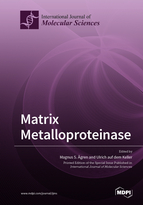Matrix Metalloproteinase
A special issue of International Journal of Molecular Sciences (ISSN 1422-0067). This special issue belongs to the section "Biochemistry".
Deadline for manuscript submissions: closed (30 June 2019) | Viewed by 80849
Special Issue Editors
Interests: zinc; wound healing; skin; MMP; wound healing modeling; gastrointestinal
Interests: proteins; biochemistry; inflammation; enzymes; bioinformatics; cancer research; proteomics; wound healing; skin; dermatology; proteome; matrix metalloproteinase; proteolysis; protease inhibitors; proteases
Special Issue Information
Dear Colleagues,
Metalloproteinases (metzincins) comprise zinc-dependent exopeptidases and endopeptidases. MMPs (matrix metalloproteinases), ADAMs (a disintegrin and metalloproteinase domain), ADAMTSs (a disintegrin and metalloproteinase thrombospondin domain), astacins (including meprins), and neprilysins are metalloendopeptidases. Metalloproteinases play fundamental roles in extracellular matrix remodeling, and cytokine/growth factor release and processing. They are involved in physiological and pathophysiological processes throughout life. We warmly welcome contributions on the molecular aspects of these enzymes, as well as their preclinical and clinical relations to innate immunity, infection, and tissue repair.
Prof. Dr. Magnus S. Ågren
Prof. Dr. Ulrich auf dem Keller
Guest Editor
Manuscript Submission Information
Manuscripts should be submitted online at www.mdpi.com by registering and logging in to this website. Once you are registered, click here to go to the submission form. Manuscripts can be submitted until the deadline. All submissions that pass pre-check are peer-reviewed. Accepted papers will be published continuously in the journal (as soon as accepted) and will be listed together on the special issue website. Research articles, review articles as well as short communications are invited. For planned papers, a title and short abstract (about 100 words) can be sent to the Editorial Office for announcement on this website.
Submitted manuscripts should not have been published previously, nor be under consideration for publication elsewhere (except conference proceedings papers). All manuscripts are thoroughly refereed through a single-blind peer-review process. A guide for authors and other relevant information for submission of manuscripts is available on the Instructions for Authors page. International Journal of Molecular Sciences is an international peer-reviewed open access semimonthly journal published by MDPI.
Please visit the Instructions for Authors page before submitting a manuscript. There is an Article Processing Charge (APC) for publication in this open access journal. For details about the APC please see here. Submitted papers should be well formatted and use good English. Authors may use MDPI's English editing service prior to publication or during author revisions.
Keywords
- metalloproteinases
- inflammation
- wound healing
- cytokines
- collagen
- connective tissue
- microbiota
- skin








